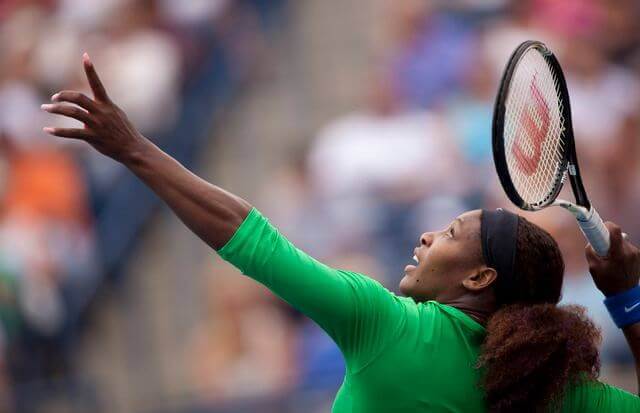There is one shot in tennis that doesn’t happen often (at least at my level), but when it does, it’s important to know how to handle it properly – and that shot is the overhead.
When done right, the overhead is a great offensive shot. It intimidates your opponent and usually ends the point in your favor. Yep, it’s a great confidence booster.
But if you’ve ever shanked an overhead, then you know it’s not an enjoyable experience. As a matter of fact, a poorly executed overhead can even change the momentum of the game. Below are some general tips and rules of thumb to help you consistently hit solid overheads.
Do the trophy pose.
As soon as you see the shot is overhead, get your racket back and your left hand up (or right hand, if you’re a lefty), and point at the ball until you hit it. Doing this helps you track the ball and be ready for it when it drops into your strike zone. Watch the pros – as soon as they see a lob is coming, their rackets are back and hands are pointing, and they’re tracking the ball – and it’s extremely rare they shank it.
Keep your eyes on the ball.
Since lobs have a lot of “hang time,” players tend to start looking around for where they want to place the ball. Before they know it, the ball is right on top of them, and they’re not in a good position to hit it. Also, know that when your eyes leave the ball, your head will shift, and even though your racket is back, it will shift as well.
Move it!
Move back with the ball when you see it is a lob. Unless you’re playing on the edge of a cliff, DON’T worry about going back too far. Actually, that’s even better because then you can take a small step or two IN and create forward momentum and really put some weight behind your overhead.
Don’t try to slam balls that drop too low.
This can even happen to the pros when they watch the ball too long, and it drops too low. Sometimes, they’ll still go for the overhead and slam the ball right into the net or into the ground – on their own side! What you should do if the ball drops too low is take it as a high volley instead and get the ball back into play.
Serve it up.
Optimally, you want to hit the ball a foot or so out in front of your body at about 1 o’clock, just like a serve. If it gets behind you, don’t smack it hard; just try to hit it back in play. Your racket face will be more open at that point rather than closed, so it will be a high ball that will go long if you hit it too hard.
Avoid swinging at the ball as hard as you can.
You don’t need to bounce it into the stands like the pros. Slow the swing down and go for placement. For most overheads, you can hit at 50% – 60% with good placement and still put it away. This allows for good ball control and placement and saves you energy.
Let it bounce.
When the lob is extremely high, it’s more difficult to judge the speed of the drop and time the overhead—even for the pros. If there is little or no spin, back up and let the ball bounce first, and then step into it and hit it as you would a serve. NOTE: It’s important that you back up far enough to accommodate any traveling of the ball after the bounce.
The overhead is an offensive shot in tennis that you can execute easily and take complete control of, and even end the point. Give these tips a try when practicing your overheads, and apply them in your matches.
Don’t forget to check out our other instruction videos and strategies for more hacks to better your game!
